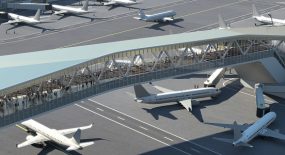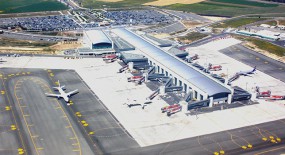VIDEO. All airports face delays from time to time and suffer from reduced throughput due to low visibility. While airports are focused on increasing capacity, sometimes they don’t know where to start. In this video, Bengt Collin, ADB SAFEGATE´s Senior Operational Advisor explains how airports can benefit from the process of developing a Concept of Operations (CONOPS), a blueprint for an airport’s operations that guides the airport at every stage and helps avoid unnecessary uncoordinated investments.
A lot of airports today operate in silos, where one part of the airport does not necessarily know what the other part is doing. The process of developing a concept of operations helps airports get a better understanding and overview of how the airport needs to ideally operate today and it also improves internal coordination to avoid inefficiency caused by those silo-effects. Analyzing before making any major investments and important decisions helps airports save both money and time. Often the solution can be integrating systems and infrastructure that already exists.
EUROCONTROL describes Concept of Operations (CONOPS) as “a tool used by an organization to establish the desired approach it wishes to take to realize a system or service. The CONOPS documents the high-level decisions and agreement that define the approach and the organizational structure needed to put that approach into operation.”
The main objective of a CONOPS at an airport is to cover end-to-end traceability between operational needs and system safety and performance requirements derived in future phases. It is a tool for airports to make sure they operate in the most efficient and safe way. If airports want to optimize their operation and increase their throughput, developing a CONOPS is often a very good way to start. By interviewing the people at the airport, going through all procedures and having the current situation presented in a report, airports can streamline their operations and more importantly avoid unnecessary uncoordinated investments.
It covers everything from push-back, taxi, signs-markings, training of vehicle drivers to low-visibility operations.
The CONOPS typically includes description of:
Operational Environment (Current and Target):
• Describes the airspace structure around the airport, including e.g. alternate airport.
• Details the operational structure, number of ATCOs, ratings, training etc., the Tower layout, Runway, Taxiway and Apron layout.
• Describes the systems the airport is using today, including but not limited to communications, A-SMGCS, weather data etc. Listing environmental needs linked to the operational objective of the work program.
Concept of ATC Services (Target)
• Raises questions such as how the approach is operating and how to handle the ground movements. What are the runway modes and the separation minima? How to operate the airport in reduced visibility and what are the airport´s Low Visibility Procedures (LVP)?
• Contains a valid high-level description on the operational service that is relevant to the project scope. Normally the Concept of ATC Services will not propose procedures since this should be the responsibility of the local experts.
Operational Scenarios
Based on the data gathered and reported in the previous sections the airport receives scenarios presented as a series of stepped illustrations showing the concept of a sequence of traffic movement over a short period of time. Both good visibility scenarios and LVP conditions are covered, as well as mixed mode or departure/arrivals only. Exact figures of the possible throughput are calculated.
User/Operational Needs
This part includes a list of Operational Needs. It focuses on how the airport´s systems should be integrated and operated to be able to support the throughput as illustrated in the previous section. The needs are directly linked to the design of the system being supplied to meet the operational objectives.
Do you want to find out if a CONOPS is the way forward for your airport? We´re here to guide you…
ADB SAFEGATE uses a six-step program tailored to help optimize airport performance. Our operational approach analyzes an airport’s current situation and aims to create a future-proof solution that boosts aircraft movements safely and optimizes airport efficiency. We know that existing infrastructure often contains hidden and unused capacity that can be released with a holistic view of the airport.
We apply an advisory, consultative approach to creating the right solution. Our aim is to propose a cost effective way to resolve an airport’s most pressing challenges, quickly and smoothly. This can encompass every aspect of air traffic control and guidance, from approach, runway and taxiway lighting, and tower-based traffic control systems, to intelligent gate and docking automation.
Our dedicated Airport Performance team is qualified to answer all your questions on how to accelerate performance at your airport. Do not hesitate to contact us at airportperformance@adbsafegate.com
ADB SAFEGATE is a leading provider of intelligent solutions that deliver superior airport performance from approach to departure. We partner with airports and airlines to analyze their current structures and operations, and jointly identify and solve bottlenecks. Our consultative approach enables airports to improve efficiency, enhance safety and environmental sustainability, as well as reduce operational costs. Our portfolio includes solutions and services that harmonize airport performance, tackling every aspect of traffic handling and guidance, from approach, runway and taxiway lighting, to tower-based traffic control systems and intelligent gate and docking automation. ADB SAFEGATE has 900+ employees in more than 20 countries and serves some 2,500+ airports in more than 175 countries.















Leave a Comment